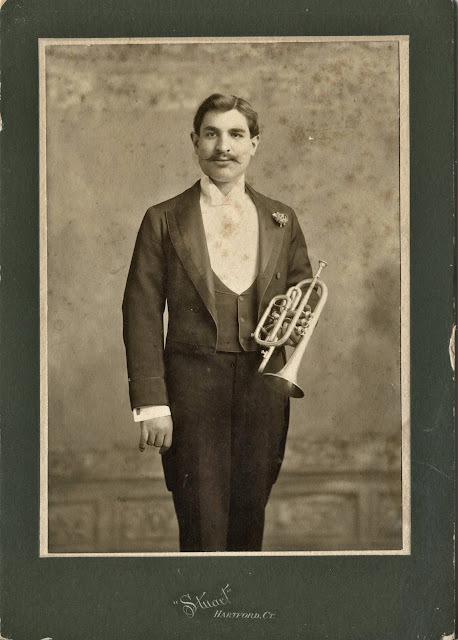It's a style of formal evening dress
that has never gone out of style.
that has never gone out of style.
A white tie and black tailcoat
was once high society's mark of a gentleman.
It implied dignified sophistication,
refined culture, gallantry
and polite manners.
was once high society's mark of a gentleman.
It implied dignified sophistication,
refined culture, gallantry
and polite manners.
Today it remains a man's preferred attire
for attending a graduation, a school prom,
a royal gala, an opera performance.
for attending a graduation, a school prom,
a royal gala, an opera performance.
or that most special occasion—his wedding day.
But a formal white tie and tailcoat
can also be a uniform.
It has been, and remains today,
the required outfit
of male musicians who perform
in a symphony orchestra.
can also be a uniform.
It has been, and remains today,
the required outfit
of male musicians who perform
in a symphony orchestra.
Today I present
four very well-dressed cornetists
who once posed for their portraits.
Their names are unknown
but their musical talent still shines through
and the gleam on their instruments
remains untarnished.
four very well-dressed cornetists
who once posed for their portraits.
Their names are unknown
but their musical talent still shines through
and the gleam on their instruments
remains untarnished.
My first cornet player hails from Fond du Lac, Wisconsin where he posed for the camera at the photography studio of Kafer & Co. on the corner of Main and 2nd St. He holds a B-flat cornet with a bell embellished with fancy engraving. His mustache is carefully waxed to an impressive handlebar style that would certainly emphasize his embouchure when playing.
This cabinet card photo was likely taken in the 1890s. Fond du Lac is on the southern end of Lake Winnebago and in the 1880-1900 era was a thriving city with a population of around 13,000 to 15,000.
* * *
My second cornetist is a young man who opted for a clean shaven style. His pose is similar to the Wisconsin player with a far-off gaze as if watching for a conductor cue to play. His cabinet card photo was produced by the Loryea Bros. of San Jose, California at 26 S. First Street. Back in the 1890s when this photo was probably taken, San Jose was not much larger than Fond du Lac with a population of 18,000.
The Leryea Brothers called their studio the Souvenir Gallery and had an elaborate imprinted on the back of the card mount. There is a single name written in the upper corner but I can't make out the first letter. Tamma or Jamma? It doesn't look like a common first or last name. Any guesses?
* * *
My third well-dressed cornetist is from Hartford, Connecticut where he posed with his instrument at the Stuart photography studio. His mustache has a tiny bit of an upturned curl that I think hints of a Germanic heritage, but that could just be a false twist. In 1890 Hartford was over twice the size of San Jose or Fond du Lac with a population then of 53,230. From 1874 to 1891 Hartford was the home of Samuel Clemens/Mark Twain so it's possible that Sam might have heard this cornetist play in concert.
* * *
My final cornetist is a very debonair young man with a trimmed mustache and a fancy engraved cornet. He is from Boston, Massachusetts where his photo was taken by Charles C. Fisher of 74 Meridian St. in East Boston. Boston, of course, was a big city even in the 1890s and arguably one of the most musical places in North America with numerous theaters and many professional musicians.
The celebrated Boston Symphony was founded in 1881 as the third major orchestra in America. The New York Philharmonic was the first, established in 1842, followed by the St. Louis Symphony in 1880. After Boston came the Detroit Symphony in 1887, the Chicago Symphony in 1891, the New Haven Symphony in 1894, the Cincinnati Symphony in 1895, the Pittsburgh Symphony in 1895, and the Philadelphia Orchestra in 1900. According to a Wikipedia entry on the San Jose Symphony Orchestra, there was a orchestra there in 1879 that gave occasional performances but a formal symphony association was not formed until 1937. Similarly in Hartford, its symphony orchestra started in 1934. But as far as I know there has never been
a symphony orchestra in Fond du Lac.
Other than their formal attire, there really isn't anything in the portraits of these four stylish cornetists that connects them to an orchestra. But it's unlikely that an amateur musicians would wear such an elegant suits or play such first-class instruments. I think it's very possible that they were concert artists or principal musicians as in the 19th century the cornet was the premier solo instrument of both bands and orchestras.
Very long time readers might remember the Boston cornet player as he was featured in A Boston Love Story which I posted in August 2011. It was my first effort at writing a short fiction based on old photos in my collection. I am rather proud of it, in part because I found this young man a companion, though it was a courtship that was not to be. But I shouldn't give away the ending. Perhaps I should write stories for the other three cornet players and turn them into a romance series!











3 comments:
Obviously Miss Annie's love was not returned. How sad. Romantic stories are supposed to have happy endings. Try again. "Notes of Love" or "White Tie and Tales" :)
There's such "pride" in old photo portraits like these ... :-)
Thank heaven for trains, where a cornetist could have a nice portrait taken in a town without an orchestra, but would be off to play in one that gave his talents opportunities! I like the idea of creating fictional stories to go along with the portraits!
Post a Comment